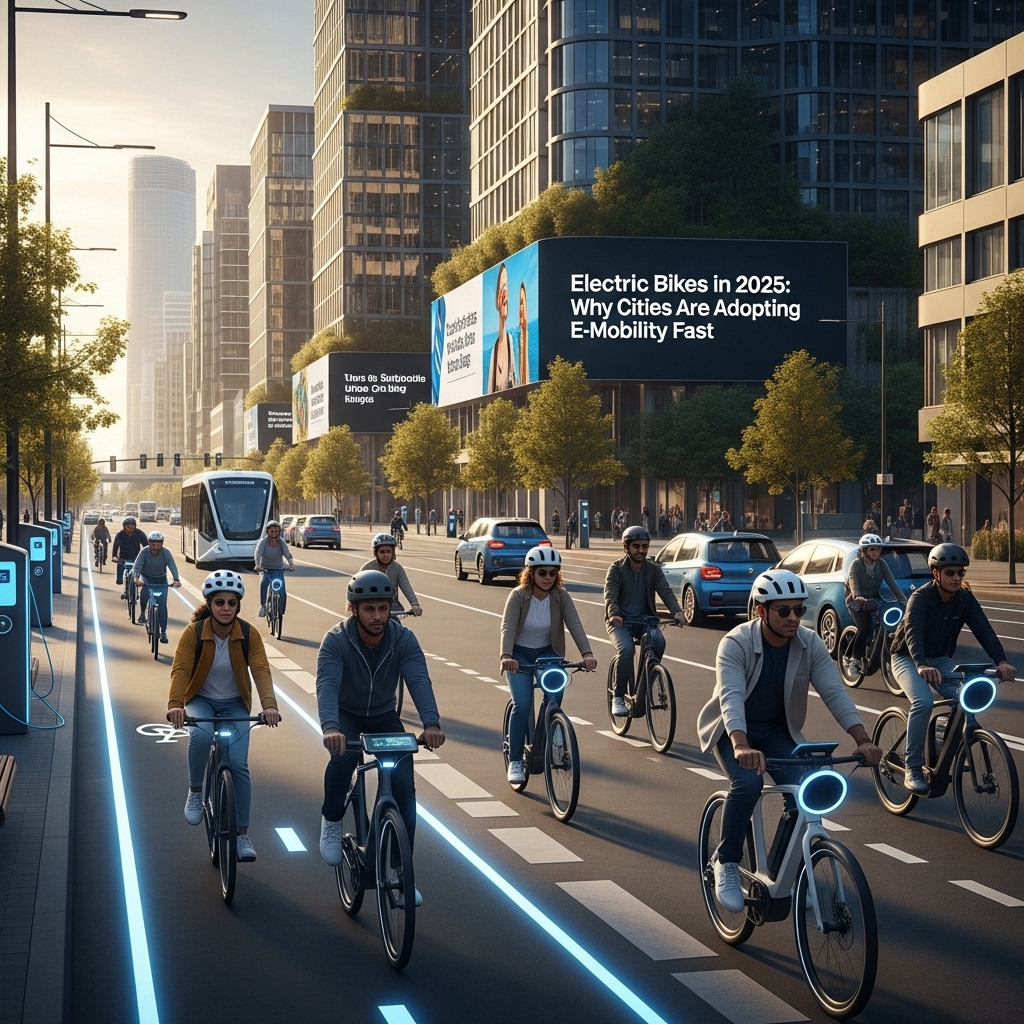
Clean, Affordable, and Fast Transport
Electric bikes reduce pollution, save fuel costs, and provide efficient mobility in crowded cities. Advanced batteries offer 150+ km ranges, fast charging, and smart IoT tracking.
Governments worldwide offer incentives, making e-bikes a mainstream commuting choice.
Electric Bikes in 2025 — Why Cities Are Adopting E-Mobility Fast
Cities aren’t just buying more e-bikes — they’re redesigning streets, subsidies, and transit plans around them. Here’s a concise, evidence-backed look at what’s driving the shift and what it means for urban life.
Quick snapshot
-
The global e-bike market is large and still growing rapidly, with major market research firms estimating tens of billions USD in value for 2025 (estimates vary by source). Grand View Research
-
Policymakers and planners now see e-bikes as a practical tool to replace short car trips and even some private two-wheelers in high-pollution markets — with big potential emissions and congestion wins. itdp.org
Why adoption is accelerating
1. It’s affordable, fast, and practical
E-bikes extend the range and reduce effort compared with conventional bicycles, making them viable for commuting, deliveries, and errands across hilly or sprawling cities. That unlocks trips that previously required cars or motorbikes, improving travel time for many users. (Observed widely in recent city bike-share rollouts and market trends.) Grand View Research+1
2. Clear climate and public-health promise
Recent research and reviews indicate e-bikes reduce greenhouse gas emissions when they substitute for car or motorbike trips, and they still deliver physical-activity benefits compared to motorized travel — a win for both emissions and public health. Cities aiming for climate targets see e-bikes as a measurable lever. Frontiers+1
3. Policy shifts & procurement
Cities are adding e-bikes to public bike-share fleets, offering subsidies and social-pricing, or restricting polluting vehicles in central areas — all of which boost demand and usage. Real examples show operators adding thousands of e-bikes to reach underserved neighborhoods and hilly zones. eiturbanmobility.eu
4. Private sector & local regulations speed adoption
Regulatory moves (for example, restrictions on petrol two-wheelers or incentives for EVs) and strong local manufacturers/operators can instantly spike sales and deployments — recent news from Asian markets shows how policy announcements can rapidly accelerate e-two-wheeler deliveries. Reuters
5. Better tech and supply-chain scale
Improvements in motors, batteries, and inexpensive manufacturing continue to lower unit costs, while growing accessory ecosystems (cargo racks, child seats, integrated locks) make e-bikes more useful for diverse users. Market reports show significant industry investment and growth. Grand View Research
What cities are changing (on the ground)
-
Infrastructure: protected bike lanes, curb redesigns, loading zones for cargo e-bikes, and secure parking/charging hubs. itdp.org
-
Programs: expanded e-bike fleets in public share schemes, social pricing for low-income users, and targeted pilots for delivery fleets. eiturbanmobility.eu
-
Policy: low-emission zones, procurement rules favoring e-modes, and incentives/subsidies for private purchases. Reuters+1
Challenges to watch
-
Equity & access: without targeted subsidies, higher-upfront cost can exclude low-income riders; social pricing and community fleets help. eiturbanmobility.eu
-
Lifecycle impacts: shared, dockless programs need good operations/maintenance to avoid waste and poor sustainability outcomes. (Some life-cycle and dockless-system studies show mixed results depending on operations.) Frontiers
-
Infrastructure & safety: protective lanes and traffic-calming are essential to make e-bikes safe and attractive for casual riders. itdp.org
What this means for cities (short list)
-
Fewer short car trips → lower congestion and emissions if policies steer mode shift. itdp.org
-
Better access to jobs and services for people without cars if fleets and subsidies are designed equitably. eiturbanmobility.eu
-
New market and regulatory work: parking rules, charging/maintenance networks, and safety campaigns.
Bottom line
E-bikes are not a gadget trend — they’re a strategic tool that cities can deploy quickly and cost-effectively to cut emissions, reduce congestion, and broaden mobility options. The impact depends on smart policy design (infrastructure + equitable access + operations) rather than technology alone. itdp.org+1
